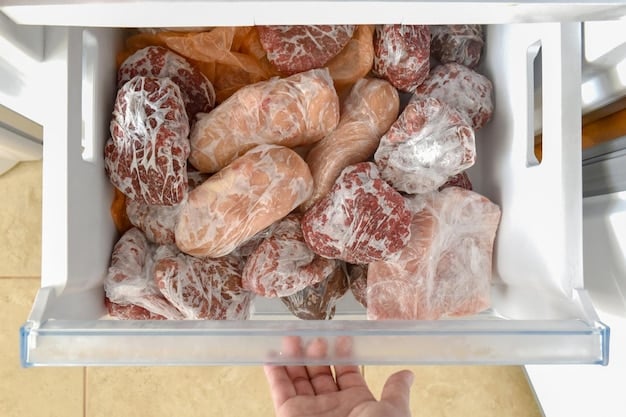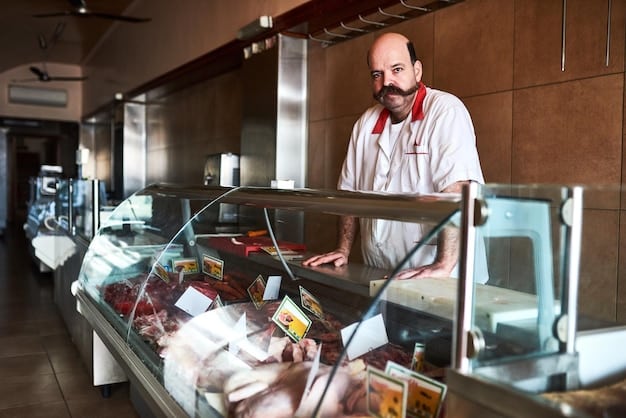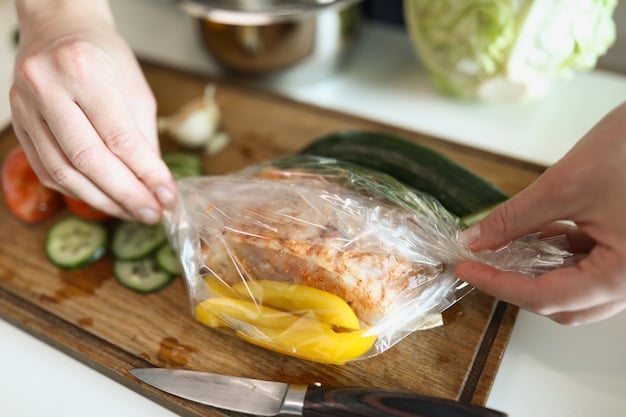Save Big on Meat: Expert Tips for Bulk Buying & Freezing

Save big on meat by mastering the art of buying in bulk and freezing properly; this comprehensive guide provides expert tips to maximize savings and ensure quality.
Want to slash your grocery bill without sacrificing your favorite meaty meals? Learning how to save big on meat: expert tips for buying meat in bulk and freezing for future savings can be a game-changer.
Why Buy Meat in Bulk? Unveiling the Benefits
Buying meat in bulk might seem daunting at first, but the potential savings and convenience are undeniable. Let’s explore the key advantages of stocking up on your favorite cuts.
Lower Unit Cost
One of the most compelling reasons to buy meat in bulk is the significant reduction in price per pound. Retailers often offer substantial discounts when you purchase larger quantities.
Convenience and Time Savings
A well-stocked freezer means fewer trips to the grocery store, saving you valuable time and effort. It’s especially convenient for busy families or individuals with demanding schedules.
- Reduced grocery shopping frequency: Plan your meals in advance and shop less often.
- Always having meat on hand: No last-minute runs to the store when cravings strike.
- Meal prepping made easy: Batch cooking and freezing become seamless.
By buying meat in bulk, you ensure you have a readily available supply, streamlining your meal preparation and reducing the stress of grocery shopping.
Smart Sourcing: Where to Buy Meat in Bulk
Knowing where to source your meat is just as important as knowing why to buy it in bulk. Here’s a rundown of the best places to find deals and ensure quality.

Local Butchers
Local butchers often offer high-quality meats and personalized service. They can provide custom cuts and advice on the best ways to prepare and store specific types of meat.
Warehouse Clubs
Warehouse clubs like Costco and Sam’s Club are popular destinations for buying meat in bulk. They typically offer competitive prices on a variety of cuts.
- Check weekly ads: Look for special promotions and discounts.
- Compare prices: Compare the unit cost with other retailers to ensure you’re getting the best deal.
- Consider membership fees: Factor in the annual membership cost when evaluating potential savings.
Online Retailers
Online retailers offer the convenience of shopping from home and often have a wider selection than local stores. Some online butchers specialize in specific types of meat, such as grass-fed beef or organic poultry.
By exploring different sourcing options, you can find the best deals and quality that suit your preferences and budget.
Essential Gear: Preparing for Bulk Meat Storage
Before you fill your freezer with meat, ensure you have the right equipment and supplies to maintain quality and prevent freezer burn.
Vacuum Sealer
A vacuum sealer is a worthwhile investment for anyone serious about freezing meat. It removes air from the packaging, preventing freezer burn and extending the shelf life of your meat.
Freezer Bags
High-quality freezer bags are essential for storing meat in the freezer. Look for bags specifically designed for freezing, as they are thicker and more durable than regular storage bags.

Sharpie or Labels
Don’t forget to label and date your meat packages before freezing. This will help you keep track of what’s in your freezer and ensure you use the oldest items first.
- Clearly label each package: Include the type of meat, cut, and weight.
- Date each package: Use a permanent marker that won’t smudge or fade.
- Organize your freezer: Keep a running inventory of what’s inside to avoid overbuying or wasting food.
Having the right gear ensures your meat stays fresh and delicious for months, maximizing your investment and minimizing waste.
Freezing Like a Pro: Step-by-Step Guide
Correct freezing techniques are crucial to preserving the quality and flavor of your meat. Follow these steps to freeze meat like a pro.
Portioning
Divide your meat into meal-sized portions before freezing. This makes it easier to thaw only what you need, preventing unnecessary waste.
Wrapping
Wrap each portion tightly in freezer paper or place it in a freezer bag. For added protection, wrap the meat in plastic wrap before placing it in the freezer bag.
Sealing
Remove as much air as possible from the packaging. If using freezer bags, press out the air before sealing. If using a vacuum sealer, follow the manufacturer’s instructions.
By mastering these freezing techniques, you can ensure your meat remains in top condition, ready to be enjoyed whenever you desire.
Thawing Techniques: Safe and Delicious
Safe thawing is just as important as proper freezing. Here are the best ways to thaw meat while preserving its quality and preventing bacterial growth.
Refrigerator Thawing
The safest and most recommended method is to thaw meat in the refrigerator. Place the frozen meat in a bowl or on a plate to catch any drips. Allow plenty of time for thawing – it can take up to 24 hours for a large cut of meat to thaw completely.
Cold Water Thawing
If you need to thaw meat more quickly, you can use the cold water method. Place the meat in a leak-proof bag and submerge it in a bowl of cold water. Change the water every 30 minutes to maintain a consistent temperature.
- Never thaw meat at room temperature: This can lead to bacterial growth and foodborne illness.
- Cook meat immediately after thawing: Don’t refreeze thawed meat unless it has been cooked first.
- Use a meat thermometer: Ensure the meat reaches a safe internal temperature when cooking.
Choosing the right thawing method is essential for maintaining the safety and quality of your meat, ensuring a delicious and worry-free dining experience.
| Key Point | Brief Description |
|---|---|
| 💰 Bulk Buying | Reduces cost per pound, saving money. |
| ⏱️ Time Savings | Less frequent grocery trips, more free time. |
| ❄️ Proper Freezing | Maintains meat quality, prevents freezer burn. |
| 🌡️ Safe Thawing | Prevents bacterial growth, ensures food safety. |
Frequently Asked Questions
▼
Most cuts of meat can be stored in the freezer for up to 12 months without significant loss of quality, provided they are properly packaged and stored at a consistent temperature of 0°F (-18°C).
▼
Freezer burn occurs when moisture escapes from the surface of the meat, causing dehydration and discoloration. To prevent it, use airtight packaging like vacuum-sealed bags or wrap meat tightly in freezer paper.
▼
It’s generally not recommended to refreeze raw meat after it has been thawed. However, if you thaw meat in the refrigerator and it remains cold, you can refreeze it within a day or two. Cooked meat can be refrozen.
▼
Yes, ground meat freezes very well. Divide it into portions, wrap tightly in freezer paper or bags, and remove as much air as possible. It can be stored in the freezer for up to 3-4 months.
▼
Vacuum-sealed bags are the best option as they remove all air. If using freezer bags, choose heavy-duty ones specifically designed for freezing. Freezer-safe containers can also be used, especially for cooked meat.
Conclusion
Mastering the art of buying meat in bulk and freezing it correctly is a skill that pays dividends in terms of savings, convenience, and culinary flexibility. By following these expert tips, you can stock your freezer with confidence, knowing that you’re making smart choices that benefit both your wallet and your palate.





